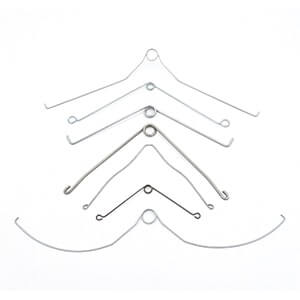Get unique, complex parts easily. No matter your requirements, Chaoyi Spring creates hard-to-produce coil springs and wire forms.
Let us help you create the custom wire form you need, from S-hooks and J-hooks to utility hooks and more.
We work closely with customers across a wide range of industries, helping them design and manufacture made-to-order parts.
Why choose Chaoyi Spring? We prioritize customer-focused collaboration, modern equipment and the latest technology to make your parts per print.
Find the information and guidance you need, from measuring a spring to learning about materials, placing an order and much more.
Tension springs, also known as extension springs, are essential components in numerous mechanical systems. They are designed to elongate when subjected to a tensile force, storing energy and returning to


Tension springs, also known as extension springs, are essential components in numerous mechanical systems. They are designed to elongate when subjected to a tensile force, storing energy and returning to their original length once the load is released. Understanding the intricacies of tension springs, including their characteristics and applications, is crucial for engineers, designers, and anyone involved in selecting and implementing these versatile components. This comprehensive guide provides a deep dive into the world of tension springs, exploring their construction, properties, applications, and the invaluable tool that is a tension spring chart.

Tension springs, also known as extension springs, are coiled springs designed to operate under tension. They are typically made of high-strength, elastic materials, such as spring steel, phosphor bronze, or beryllium copper. Their construction involves winding a wire around a mandrel to form a helical coil. When a tensile force is applied to the ends of the spring, it elongates, storing potential energy. Once the load is removed, the spring retracts to its original length, releasing the stored energy. This unique characteristic makes tension springs ideal for various applications requiring elastic behavior, including retracting mechanisms, clamping, and suspension systems.
A tension spring chart, also known as a spring chart or spring data sheet, is a crucial tool for understanding and selecting the right tension spring for a specific application. These charts provide valuable information about a variety of tension springs, often categorized by their material, wire diameter, coil diameter, number of coils, and other relevant parameters. The most important information on a tension spring chart is the spring rate, also known as the spring constant.
The spring rate (k) represents the force required to extend the spring by a specific distance. It is expressed in units of force per unit of displacement, such as pounds per inch (lb/in) or newtons per meter (N/m). A higher spring rate indicates that more force is needed to extend the spring by the same distance. Conversely, a lower spring rate means less force is required for the same extension.
Tension spring charts often include other important parameters such as free length, solid height, load capacity, and spring index. Understanding these parameters allows engineers to select a spring that meets the specific requirements of their application.
Tension spring charts are invaluable tools for engineers, designers, and manufacturers involved in various industries. Their comprehensive information helps in:
Tension spring charts typically include the following information:
The spring rate is one of the most critical parameters on a tension spring chart. It represents the spring's stiffness or resistance to deformation. A higher spring rate indicates a stiffer spring, meaning it requires more force to extend it a certain distance. Conversely, a lower spring rate represents a softer spring, requiring less force for the same extension.
Understanding the spring rate is crucial for several reasons:
Using a tension spring chart effectively requires careful consideration of the application's specific requirements:
Tension spring charts are indispensable tools for engineers and designers working with tension springs. By providing comprehensive information about spring parameters, these charts facilitate efficient selection, performance prediction, and design optimization. Understanding the spring rate and other key features on the chart is critical for selecting the right spring for a specific application. With careful consideration of the application's requirements, engineers can leverage the valuable data on tension spring charts to ensure optimal design and performance of their systems.
Remember, selecting the right tension spring is crucial for the success of your mechanical design. By understanding the information provided in a tension spring chart, you can make informed decisions, ensuring your system operates reliably and efficiently. So, delve into the world of tension spring charts and unlock the potential of these versatile components for your mechanical endeavors.
Browse some of the custom wire forms and springs that we manufacture. Don’t see what you need? We specialize in made-to-order products that meet your application requirements.
Visit Our GalleryNeed a custom wire form or coil spring? We make it work. Fill out the contact form and a representative will respond within 1 business day. If you have a PDF or CAD file, you can submit to request a quote.